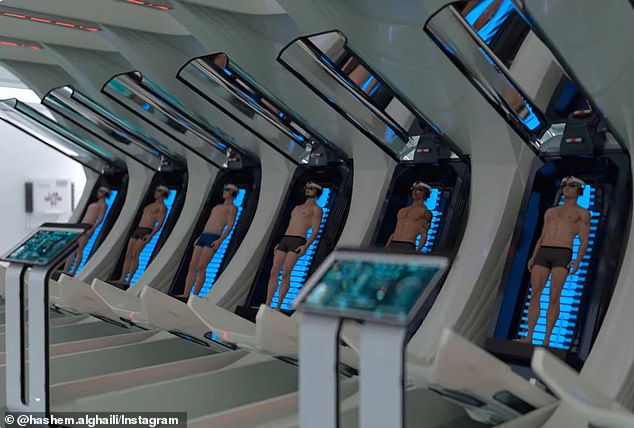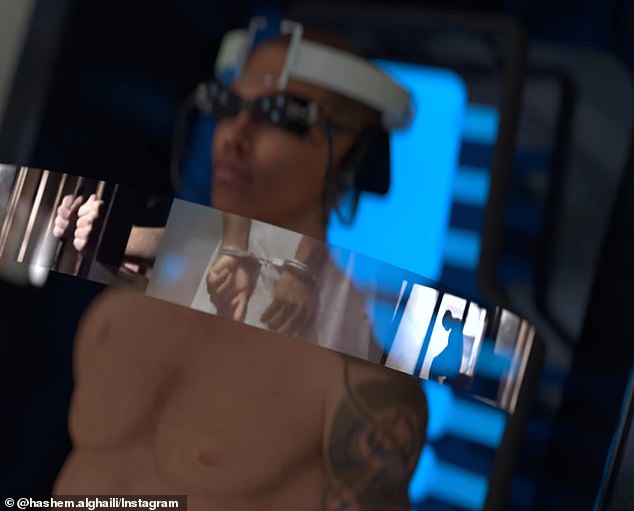A scientist has revealed a concept for a prison of the future which he claims would speed up the release of a criminal to minutes, rather than years or decades.
Called Cognify, the design would implement synthetic memories of a person’s crime in their brain, but showing the perspective of their victim.
The system could include a virtual reality-like device that displays AI-generated images of the crime, along with a brain implant that induces emotional states such as remorse or regret, feelings that some individuals may not produce on their own.
The concept, developed by Hashem Al-GhailiIt would ensure the long-term effects of the therapy session by making the memories permanent.
Called Cognify, the design would implant synthetic memories of a person’s crime into their brain, but showing the perspective of their victim.
There are currently more than 1.7 million people incarcerated in the United States.
While officials have long said that prison deters criminals from committing future crimes, more than 100 studies conducted in 2021 found that it does not prevent people from reoffending.
With this in mind, Al-Ghaili looks to the future with a prison that he believes will help criminals learn from their past.
“Cognify could one day create and implant artificial memories directly into a prisoner’s brain,” a narrative video said.
“These complex, vivid and realistic memories are created in real time using AI-generated content.
While rehabilitation would last several minutes, to the criminal it would seem like years.
“Inside the criminal’s mind, time would pass differently slower than in real life, causing them to experience years,” the video shares.
Depending on the severity of the subject’s crime and their sentence, the memories could be tailored to each subject’s rehabilitation needs.’
Prisoners undergo high-resolution brain scans that create a detailed map of their neural pathways.
The map allows the Cognify device to target specific brain regions responsible for memory, reasoning, and logical thinking.
These tasks are found in the hippocampus, prefrontal cortex, amygdala, parietal lobe, and anterior cingulate cortex.
The device goes to work by showing the prisoner AI-generated memories of their crimes, which can include domestic violence, hate and discrimination crimes, embezzlement, insider trading, theft and fraud.
In addition to visual effects, the technology could also stimulate a physical response by allowing the offender to feel the pain and suffering his victim endured.
“Some memories are designed to trigger consequences and trauma,” the video states.
“These memories could simulate the long-term consequences of violent actions, such as the grief of the victim’s family or the physical and emotional trauma suffered by the victim.”

The capsules open to reveal men standing inside each, wearing the Cognify device above their heads and what appeared to be a screen over their eyes and headphones over their ears, immersing them in AI-generated memories.
The six-minute, 22-second clip, posted to Al-Ghaii’s social media accounts, begins with a view of a white room with 19 capsules against the wall.
The capsules open to reveal men standing inside each, wearing the Cognify device above their heads and what appeared to be a screen over their eyes and headphones over their ears, immersing them in AI-generated memories.
“The artificial memories implanted by Cognify would seamlessly incorporate into the brain’s existing neural networks, preventing cognitive dissonance and ensuring that the subject experiences the memories as if they were real,” according to the video.
As prisoners endure vivid memories of their crimes, a central computer collects data to understand what motivates people to commit such crimes.
However, the video noted that Cognify would “feature encrypted storage for sensitive prisoner information and rehabilitation data.”
“The Cognify concept could revolutionize the criminal justice system by significantly reducing the need for long-term incarceration and its associated costs,” according to the concept video.
‘Traditional prisons require substantial budgets for construction, maintenance, staffing and inmate care, including food, health care and rehabilitation programs.
“By replacing long prison sentences with short, intensive rehabilitation through artificial memory implantation, the costs of maintaining prison facilities and supporting prisoners could be dramatically reduced.”


